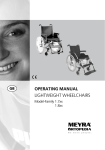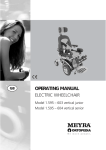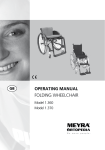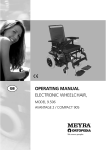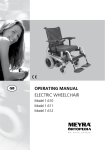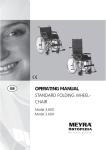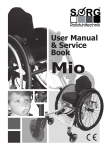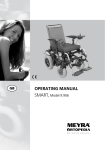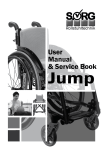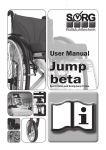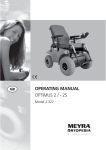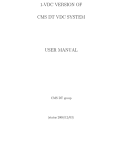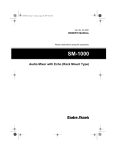Download Meyra 1.736 Specifications
Transcript
GB OPERATING MANUAL FOLDING WHEELCHAIR, MODEL 1.736 W e m o v e p e o p l e . Contents Introduction .................................................................................................. 6 Acceptance .................................................................................................... 7 Adaptation .................................................................................................... 7 Handling the wheelchair ............................................................................. 7 Specifications ........................................................................................................7 Use .........................................................................................................................8 Auxiliary drives .....................................................................................................8 Overview ....................................................................................................... 9 Driving behaviour ...................................................................................... 10 Safety information .............................................................................................10 Supplementary user/safety information...........................................................10 Brake ............................................................................................................ 12 Pressure brakes ...................................................................................................13 Locking the pressure brakes.........................................................................13 Releasing the pressure brakes......................................................................13 Drum brake for attendant ...........................................................................14 Leg supports ............................................................................................... 16 Calf strap ........................................................................................................16 Folding up the footplates ............................................................................17 Swivelling away the leg supports ................................................................17 Dismantling the leg supports .......................................................................18 Attaching the leg supports ..........................................................................18 Adjusting the height of the footplate ........................................................19 Angle adjustable footplates.........................................................................19 Continuous leg support .....................................................................................20 Folding up the footboard ............................................................................20 Folding down the foot board ......................................................................20 Height adjustment of the footboard ..........................................................20 Adjusting the height of the footboard .......................................................21 Angle adjustable footboards .......................................................................21 2 Height-adjustable leg support ..........................................................................22 Folding up the foot plates ...........................................................................22 Swivelling off and removal of the leg supports .........................................22 Attaching the leg supports ..........................................................................23 Height adjustment of the leg support ........................................................23 Adjusting the height of the footplate ........................................................24 Depth adjustment of the calf cushion.........................................................24 Armrests ...................................................................................................... 25 Remove the arm support..............................................................................25 Inserting the arm support ............................................................................26 Height adjustment of the arm supports .....................................................26 Mudguard.................................................................................................... 27 Adapting the clothes guard .........................................................................27 Seat .............................................................................................................. 28 Seat strap, standard ......................................................................................28 Seat cushion ........................................................................................................29 Adjusting the seat depth ..............................................................................29 Back support ............................................................................................... 30 Back support belt, standard ..............................................................................30 Adjusting the back support belt ..................................................................30 Angle adjustable back support .........................................................................31 Adjustment of the back support angle .......................................................31 Adjustment of the back tube bracket .........................................................31 Height adjustable back support ........................................................................32 Adjusting the back support height .............................................................32 Adjustable back ..................................................................................................33 Push handles ............................................................................................... 35 Height adjustable push handles........................................................................35 Height adjustment ........................................................................................35 Removing the push handles .........................................................................36 Inserting the push handles ...........................................................................36 Push handles with tube guidance .....................................................................37 Height adjustment ........................................................................................37 Adjusting the clamping strength .................................................................37 3 Wheels ......................................................................................................... 38 Drive wheels .......................................................................................................38 Quick release axle .........................................................................................38 Handrims .............................................................................................................39 Steering wheels ..................................................................................................39 Tyres .....................................................................................................................39 Support castors .......................................................................................... 40 Swivel-away support castors .............................................................................40 Swinging the support castors.......................................................................40 Insertable anti-tip castors ..................................................................................41 Removing/attaching the support castor......................................................41 Adjusting the support castor .......................................................................41 Correct support castors length.....................................................................41 Manoeuvre rollers ...................................................................................... 42 Shunting castors without brakes ......................................................................42 Seatbelt ....................................................................................................... 43 Fastening the seatbelt with buckle .............................................................43 Adjusting the belt length .............................................................................43 Therapy table .............................................................................................. 44 Mount the therapy table ..............................................................................44 Individual adjustment ............................................................................... 45 Seat height /Seat angle ......................................................................................45 Drive wheel position .....................................................................................46 Steering wheel position ...............................................................................46 Back support belt height ...................................................................................47 Folding/Transport ....................................................................................... 48 Folding/Unfolding ..............................................................................................48 Folding the wheelchair .................................................................................48 Carrying the wheelchair ...............................................................................49 Unfolding the wheelchair ............................................................................49 4 Loading and transportation ...................................................................... 50 Safety information ........................................................................................50 Transport in vehicles .....................................................................................50 Transport security ..........................................................................................50 Transport in handicapped transport automobile ............................................51 Maintenance ............................................................................................... 53 Cleaning and Care ..............................................................................................53 Upholstery and covers ..................................................................................53 Plastic parts ....................................................................................................53 Finish ..............................................................................................................53 Chassis ............................................................................................................54 Disinfection .........................................................................................................54 Reinstallment ......................................................................................................54 Maintenance ............................................................................................... 54 Maintenance instructions ..................................................................................55 Flat tyre ...............................................................................................................58 Tyre change ...................................................................................................58 Adjusting the brakes ..........................................................................................59 Fine adjustment of the pressure brakes ......................................................59 Repair ..................................................................................................................60 Customer service.................................................................................................60 Spare parts ..........................................................................................................60 Disposal ..........................................................................................................60 Inspection.................................................................................................... 61 List of annual maintenance work .....................................................................62 Inspection certificate through the dealer ........................................................63 Technical specifications ............................................................................. 65 Tools.....................................................................................................................69 Tightening torque for screwed connections ....................................................69 Meaning of the labels on the wheelchair ........................................................70 Notes............................................................................................................ 71 Guarantee ................................................................................................... 74 5 INTRODUCTION We thank you for the confidence you have placed in our company by choosing a wheelchair from this series. This manual is to help you get accustomed to the handling of the wheelchair as well as to prevent accidents. ☞ Note: Please note that the illustrated equipment variants can deviate from your model. The model 1.736, fulfils the wish for mobility and more independence by way of a new styling of the proven MEYRA technology. With all equipment and their accessories the wheelchair offers die respective adaptation to your disability. Like any other vehicle, a wheelchair is a technical aid. It requires explanation, a little care and holds dangers when used improperly. The correct handling must therefore be learned. – We have therefore also listed chapters with options that might not be applicable for your vehicle. ! Attention: Read and observe the following documentation belonging to the wheelchair before first operation: – this operating manual, – the safety information < Mechanical wheelchairs >. ☞ Note: Children should read the documentation belonging to the wheelchair together with their parents respectively a supervisor or attendant before first use. 6 ACCEPTANCE All products are checked for faults in the factory and packed in special boxes. ☞ Note: ☞ However, we request that you check the vehicle for possible transport damage immediately on receipt – preferably in the presence of the carrier. ☞ The packaging of the wheelchair should be stored for a further transport that might become necessary. HANDLING THE WHEELCHAIR Specifications The wheelchair, model 1.736 was developed for adults and adolescents. Three frames are available: – short, – medium, – long. The wheelchair solely serves to transport one person in the seat and not as a hauling aid, transporters or similar. ADJUSTMENT Our specialist workshop supplies your wheelchair ready for use and adjusted to suit your special requirements. ☞ Note: The tools required for adjustments and maintenance is listed under chapter < Technical Data >. 7 Use Auxiliary drives Through its constructive advantages the wheelchair can universally be implemented on hard surfaces and therefore an allround-wheelchair: Before attaching auxiliary drives the following notes have to be considered: – for indoors (e.g. apartment, day care), ! – outdoors (e.g. in parks), – as a companion on tours (e.g. in a bus or train). The wheelchair offers manifold adjustment possibilities to individual vital statistics. The wheelchair should be adapted to your needs by a specialist dealer before the first use. The adaptation will take into account the driving experience, the physical limits of the user and the main place of use of the wheelchair. ! 8 Attention: Always have adaptation and adjustment work carried out by a specialist dealer. Attention: Attachment of auxiliary drives may only be done on wheelchair models cleared for these. ☞ The list of wheelchair models cleared for auxiliary drives can be acquired at any authorised dealer. OVERVIEW The overview shows the most important components of the wheelchair. 1 2 9 3 4 5 13 8 7 6 Pos. Description 1 2 3 4 5 6 7 8 Back support Arm support Seat cushion Leg support Calf strap Footrest Steering wheel Toggle joint Brake 12 11 10 Pos. Description 9 10 11 12 13 Push handle Side element Handrims Drive wheel Tilt aid brake/Pressure 9 DRIVING Alignment of the driving behaviour and the personal abilities is to be carried out together with your specialist dealer or therapist and is achieved after a short acquaintance period, test drive. ! Attention: Drive with extreme caution during these first trips! • Observe the section < driving training > in the safety instructions < Mechanical wheelchairs >! Safety information ! Attention: Please follow all instructions in the safety information < Mechanical wheelchairs >. • A directly opposed change of direction from backward motion without steering into a forward motion with simultaneously inward swivelling steering wheels has the effect of a full stop. • Applying a safety belt prevents falling out toward the front. • In order to raise the backward tilting stability supporting wheels can be mounted later on. • When propelling the wheelchair over the tyre there is a risk of injury in the area of the pressure brake. 10 Supplementary user/safety information • Clean, passive lighting is required for driving in public traffic. • Do not throw or drop parts belonging to the wheelchair! – Detachable parts like e.g. side elements and drive wheels have to be used properly To guarantee their function. • Removable parts, e.g. side elements and drive wheels must be checked for correct locking before starting to drive. Drive wheels with defective linchpin (quick-fit) axles can detach from the wheelchair during the drive. • By adding on or removing accessories/components the dimensions and weight of the wheelchair change which can affect the driving behaviour. • Never leave children/adolescents in wheelchairs unsupervised. • Always approach small obstacles, e.g. steps or curbs, slowly and at a right angle (90°) until the steering wheels almost touch the obstacle. Briefly stop the wheelchair and then drive over the obstacle. • Keep well clear of rail grooves, rails and gully covers or similar sources of danger. If not possible, cross such obstacles at a right-angle (90°). • Maintain a sufficient safety distance between the wheelchair and drops, steps and obstacles. This distance must allow enough time to react and enough distance to brake/turn. • Tyres are made of a rubber mixture and can leave permanent or difficult-to-remove marks on some surfaces (e.g. plastic, wooden or parquet flooring, carpets, mats). • To prevent damages due to corrosion do not use ore store the wheelchair in damp rooms. Recommendation for driving in twilight or darkness • Avoid as far as possible driving on roads or bicycle paths during darkness. Wear light-coloured clothing that can be seen at a distance. • Always reduce the speed before a curve. A sharper curve requires a lower speed. Never lean outwards in a curve. 11 BRAKE By locking the brakes the wheelchair is to secured against unintentional rolling off (parking brake). 1 The locking brake belongs to the most important safety features of a wheelchair and is available as a pressure brake (1). ! Attention: Please observe the maintenance instructions as well as instructions in the section < General safety instructions > and < Brakes > in the safety instructions < Mechanical wheelchairs >. • The wheelchair loaded with the user may not let itself be pushed in with the brakes engaged. • In order to prevent an unintentional curve while braking the wheelchair on slopes, both brakes are to be activated simultaneously. – Depending on the inclination of the road a sideward tilting has to be reckoned with. • Do not support the body on the lateral brake levers. • The brake performance reduces with – tyre profile is worn – tyre pressure is too low – tyres are wet. 12 ! Attention: Arrange an immediate repair of the brakes by your specialist workshop if the braking performance reduces. • Do not park wheelchairs with PU tyres with activated pressure or butterfly-brakes. – Deformations in the running surface may remain. • If possible propel the wheelchair over the handrims. – Perhaps danger of jamming in the area of the brake! Pressure Brake A metered braking from driving speed (operating brake) is possible with the brake levers (1) of the pressure brakes. Service brake 1 Press the two brake levers evenly only slightly to the front, this brakes the wheelchair in a metered fashion. Locking the pressure brakes To secure the wheelchair against any unintentional rolling, press both brake levers forward all the way (1). 2 ☞ Note: It should not be possible to push the wheelchair forward when both brakes are locked. Releasing the pressure brakes Pull both brake levers back all the way (2). 13 Drum brake for attendant A metered braking from driving speed (operating brake) is possible with the brake levers of the drum brakes. The wheelchair is also to be secured against unintentionally rolling away (parking brake) by engaging these brakes. 1 Locking the drum brakes Pull both brake levers evenly to secure the wheelchair against unintentional rolling away. Press the latch (1) forward. Release the brake lever. – Depending on the adjustment the latch engages in the first (A) or second (B) locking position and activates the brake. ☞ Note: ☞ The wheelchair loaded with the user may not let itself be pushed in with the brakes engaged. ☞ If the third locking position (C) is required to activate the brake, it must be readjusted by a specialist workshop. 14 C B A Loosen the drum brakes Pull both brake levers (1) until the latches (2) automatically jump out of the lock. Release both brake levers. – The parking brakes are release and the wheelchair ready to go. ! Attention: For driving the front and rear brake levers must be disengaged. 2 1 ☞ Note: The braking effect depends upon: – the condition of the tyres, – the condition and attachment of the brakes, – the brake lever adjustment, – the road condition. ! Attention: The braking effect decreases with: – worn brake pads, – loose brake lever, – defective drum brakes. • If the effect of the brake lessens immediately have them readjusted in a specialist workshop. 15 LEG SUPPORTS !• Attention: Do not use the leg supports to lift or carry the wheelchair. 1 The parking brakes are to be engaged before all assembly work. – This prevents the wheelchair from rolling away accidentally. Calf strap The calf strap (1) prevents the feet from sliding off of the footplates. – It is guided around special ligament (2) and adjusted in length with a velcro fastener. Removal of the calf belt is achieved by opening the velcro straps. ! 16 Attention: Never drive without leg strap (except when shuffling)! – The leg strap is omitted for height adjustable leg supports and is replaced by the leg padding. 2 Folding up the footplates The footplates are to be folded up for entry into, exiting the wheelchair or scuttling (forward motion of the wheelchair with the feet) (1). Turning the leg supports to the side For easy transfer out of/into the wheelchair as well as driving closer to a closet, bed or bathtub the leg supports can be swivelled away toward the in-/outside (3) and (4). 1 – Therefore pull or press the respective locking lever (2) and swivel the corresponding leg support inward/ outward. 2 ☞ Note: For this the calf strap is to be loosened on one side. ! • Attention: Swivelled-away leg stump supports are automatically unlocked and can easily fall off. Note this when handling (e.g. transport). When swivelling them back make sure that the leg support audibly locks into place. ☞ Note: 3 After swivelling the leg support inward again do not forget to check the corresponding locking device. Afterwards replace the calf strap. 4 17 Removing the leg supports For easy transfer into and out of the wheelchair as well as a reduced wheelchair length (important for transport) the leg support can be removed (1). ☞ Note: Before swivelling the leg support loosen or remove the calf belt on one side. 1 – Remove both feet from the footplates. – Pull or press the locking lever backward (2). – Swivel the leg support sideways and take them off toward the top (1). Attaching the leg supports With the leg support in a swivelledaside position, hang it in and then swivel it to the front until the locking device audibly latches. ☞ Note: After swivelling the leg support inward again do not forget to check the corresponding locking device. Afterwards replace the calf strap. 18 2 Adjusting the height of the footplate Remove the clamping screw (1) to adjust the height. 1 Telescope the foot plate to the desired height and then secure it with the clamping screw. Angle adjustable footplates After loosening the clamping screw (2) pull out the dovetail connection and adjust the angle of the footplates. ☞ The setting screw (3) serves to horizontally correct the angle of the footplates. Afterwards retighten the clamping screw. – In doing so the teeth of the angle adjustment must join again 2 3 19 Continuous leg support The footboard of the continuous leg support (1) can be folded up to the side. Folding up the foot board For an unobstructed foot area, fold up the left side of the foot board to the right as far as it will go (2). 1 Folding down the foot board Fold down the left side of the foot board until it rests on the foot board holder (3). Height adjustment of the footboard 2 Loosen the clamping screw (4) to adjust the height. Telescope the foot plate to the desired height and then retighten the screw. ☞ Note: The maximum extension is indicated by a marking (6) on the tube (5). 3 4 6 5 20 Adjusting the height of the footboard 1 Loosen the clamping screw (1) to adjust the height. Telescope the footboard to the desired height and then retighten the screw. Angle adjustable footboards After loosening the clamping screw (2) pull out the dovetail connection and adjust the angle of the footplates. Afterwards retighten the clamping screw. – In doing so the teeth of the angle adjustment must join again 2 21 Height-adjustable leg support Folding up the footplates For entry and exiting the footplates (1) are to be folded up and the calf cushions (2) swivelled outward in driving direction. 2 1 Swivelling off and removal of the leg supports For easy transfer out of/into the wheelchair as well as driving closer to a closet, bed or bathtub the leg supports can be swivelled outward and removed. 3 ☞ Note: ☞ Operate parking brakes. – This prevents accidental rolling of the wheelchair (see section < Brakes >). – Swivel the calf cushions in driving direction outward. – Remove both feet from the footplates. – Pull or press the respective locking lever (3) backward and swivel the respective leg support outward and remove it to the top if necessary. ! • 22 Attention: Swivelled-away leg stump supports are automatically unlocked and can easily fall off. Note this when handling (e.g. transport). When swivelling them back make sure that the leg support audibly locks into place. ☞ Note: After swivelling the leg support inward again do not forget to check the corresponding locking device. – Afterwards swivel the calf cushion inward again. Attaching the leg supports With the leg support in a swivelledaside position, hang it in and then swivel it to the front until the locking device audibly latches. ☞ Note: After swivelling the leg support inward again do not forget to check the corresponding locking device. 1 – Afterwards swivel the calf cushion inward again. Height adjustment of the leg support When seated in the wheelchair, ask a carer to raise the leg support to the desired level. The length adjustment is given through the turning point at the height of the knee joint. To lower the leg support, remove the load momentarily from the support by raising the lower thigh (ask an attendant if necessary), and loosen the clamping lever (1). Attention: Never put the free hand into the adjustment mechanism while adjusting the height adjustable leg support. – Danger of crushing! The leg support can now be moved slowly downwards. ! • Operate parking brakes. – This prevents accidental rolling of the wheelchair (see section < Brakes >). • Do not let the leg support drop on its own weight. – Danger of squashing! After the adjustment retighten the clamping lever (1). 1. First secure the leg support with one hand against folding down, and then loosen the clamping lever (1). 2. Have the leg support lifted to the desired level by an attendant and retighten the clamping lever (1). 23 Adjusting the height of the footplate Loosen the clamping screw (1) to adjust the height. ☞ Note: ☞ Loosen the clamping screw (1) so 1 far that no damage to the coating occurs during the adjustment. ☞ Observe the maximum extension mark (2). Telescope the foot plate to the desired height and then retighten the clamping screw (1). Depth adjustment of the calf cushion Depth adjustment of the calf plates is achieved after removing the respective screws (3). 2 Reassemble the screws (3) after the depth adjustment. 3 24 ARM SUPPORTS !• Attention: Do not use the arm supports to lift or carry the wheelchair. 1 Do not drive without the arm supports! • If possible propel the wheelchair over the handrims. – Danger of jamming between drive wheel and arm support! • When being pushed by the attendant the user has to keep his hands on the arm supports or in his lap and not at the sides between body and arm support. – Danger of jamming when sticking the fingers through the openings of the arm support! 2 ☞ To transfer into/out of the wheelchair the arm support can be swivelled backward (2). Remove the arm support – Press the locking button (1) to remove the arm support. – Swivel the arm support upward (2) and lift it off toward the top(3). 3 25 Inserting the arm support To attach the arm support insert the bolt currently in the slanted position (1) into the respective receptacle (2). 3 1 ☞ When swivelling down the arm 2 support, take care that the bracket (3) grips around the back tube. – Swivel the arm support forward into the corresponding receptacle until the locking button (4) audibly engages. 4 ☞ Note: The swivelling forward automatically engages the rear locking device of the arm support. Height adjustment of the arm supports – For height adjustment of the arm support secure the support pad with one hand to prevent it from falling down. – Then activate the release button from the inside (5) with the other hand. – Now slide the arm support into the desired position, release the spring button (5) and let it snap into place by sliding the arm support into the next possible position (6). 5 6 26 CLOTHES GUARD X 4 The distance (X) to the clothes guard running parallel to the wheel diameter (1) is to be aligned to the selected wheel position. ! Attention: The distance X between the driving wheel and the mudguard should be as small as possible (approx. 1 cm). – Danger of crushing! Adapting the clothes guard – Remove the corresponding drive wheel. ☞ Hereto observe chapter < Drive wheels >. 2 – Dismantle the screwed connections (2). – Position the clothes guard (1) to the equalising wheel circumference. – Reassemble the screwed connections (2). 3 ☞ Note: ☞ After removing the clothes guard the attachment clamp (3) can be dismantled, turned by 180° and be reassembled. By this further attachment positions are possible for the clothes guard. ☞ After alignment to the wheel circumference check the functions of the arm support. 27 SEAT Seat strap, standard 1 The seat strap (1) is tensed through the seat tubes and can be bent upward in the middle for folding (2). ☞ Therefore observe chapter < Folding/Unfolding >. 2 28 Seat cushion The seat cushion is aligned to the centre and placed from front to back onto the velcro straps at the sides of the adjustable seat strap (1). The seat cushion can be removed toward the top for folding (2). – Velcro fastener. 1 Adjusting the seat depth The seat depth can be continuously adjusted by max. 3 cm by sliding the front adjustable seat strap (3). ☞ Note: For this slide the two velcro seat straps parallel on both sides. Afterwards realign the seat cushion and place it in the centre (4). – Velcro fastener. 2 3 4 29 BACK SUPPORT Back support belt, standard The back strap is tightened through the back tubes (1). The extended back support element is velcro strapped underneath the seat strap. 1 Adjusting the back support belt Two holes each are already in the back tubes t attach the back strap (2). 1. Screw out the attachment screw (3) on each side. 2. Adjust the back support strap in height. 3. Screw the attachment screw (3) on each side through the back support strap into the back tube and tighten (2). ! 30 Attention: The height adjustment of the back strap is only to be done in a specialist workshop. 3 2 Angle adjustable back support The angle adjustable back support (1) can be adjusted in angle by +/- 10° in 5°-steps. Adjustment of the back support angle – Therefor remove the arm supports (2). 1 ☞ Observe chapter < Arm support >. – Then screw out the attachment screws (3) on both sides (2). 3 – Then adjust the back support tubes parallel to the desired back angle. – Then remount the screws on both sides (3) and adjust the back tube brackets on both sides. 2 Adjustment of the back tube bracket 4 – First loosen the clamping screw (4) of the back support bracket of each arm support and slide it backward (5). – Then reinsert the arm supports (5). – Then slide the back support bracket of each arm support into the respective back tube (6) and tighten the clamping screw (4). 5 4 6 31 Height adjustable back support The height adjustable back support (1) is continuously adjustable in height (2). Adjusting height the back support – Therefor remove the back cushion (3). – Velcro fastener. 1 ☞ Observe chapter < Adjustable back support >. – Then loosen the clamping screws (4) on both sides and adjust the back tubes parallel according to the cm scale at the side to the same height (5). – Then retighten the attachment screws (4) on both sides. 2 ☞ The telescopic tubes are secured by a spring wire within the tube to prevent them from being pulled out completely. ☞ If the spring wire is defective the 4 telescopic tubes can be adjusted to max. 15 cm according to the scale (5). ☞ Defective spring wires can be re- 3 placed in the specialist workshop. 5 32 4 Adjustable back The adjustable back is adjustable through a velcro strap, the so called spanning straps (1). The cushion (2) is placed over it and attached with the velcro strap. 1 2 Adjusting the adjustable back ☞ Note: ☞ The fitting of the adjustable back (1) is best carried out with the user sitting in the wheelchair and the seat angle is set at 0°. ☞ Adjustment is carried out from the bottom to the top. ☞ The lower part of the adjustable back should remain slightly loose so that it adapts to the buttocks when bending forward. ! 2 Attention: The overlapping of the Velcro fastener has to be at least 10 cm! 1. Pull off the rear part of the cushion. 2. Span the spanning straps tightly over the small of the back and lumbar spine in order to give maximum support. 3. Adjust the remaining straps to the form of the back. 4. Afterwards loosen the front part of the cushion and align it with the spanning straps. ☞ In doing so the user should lean forward. If necessary ask an aid to help out! 33 Place the back cushion The back cushion (1) is to be folded over in the centre between the two horizontal seams 180° around the upper spanning straps (2), (3). – This creates a soft upper edge. 1 2 ☞ Note: When the user leans against the front cushion again, pay attention that: 3 ☞ The pressure of the back must be spread evenly throughout the back cushion. ☞ A complete hand should fit in between the cushion and back at the upper edge of the back cushion. ☞ The head of the user must be held at balance by the back cushion. 4 The extended parts of the back support are fastened to the top or bottom seat surface depending on the adjusted back support height (4). ☞ Note: With an adjusted back support height from 9 cm according to the scale on the side, the straps of the back cushion are led around the back tubes (5). 34 5 PUSH HANDLES Height adjustable push handles The height adjustable push handles (1) are attached to the back support with a clamping jig each (2) and can be adjusted to the requirements of the attendant. 1 The push handles are continuously height adjustable, swivelling in steps of 30° and secured against being pulled out. ☞ Note: Further varieties of push handles are optionally available at you specialist dealer. 2 Height adjustment – Loosen the clamping screw with the clamping levers (2) so far that the respective push handle can be adjusted into the desired position. – Lift the push handle to the desired height. – Retighten the clamping screw with the clamping levers (2). Special features of the clamping lever The clamping lever (2) can be turned into an operation position that is comfortable for you. – For this pull the lever outward, until the teething is released. – After turning the lever let the teething engage again. 35 Removing the push handles Loosen the clamping screw with the clamping lever (3) and pull the according push handle up as far as it will go. Press the respective spring button (1) inward and pull the push handle out of the clamping device (2). Inserting the push handles Press down the spring button (1) and insert the push handle from the top into the respective clamping device (2). Push the push handle through the clamping device (2) and retighten the clamping screws with the clamping lever in the desired position (3). 36 4 5 3 Push handles with tube guidance The push handles (1) are guided swivel-proof inside the back tube and steplessly height by up to 10 cm. 2 Height adjustment – First hold onto the push handle that is to be adjusted then swivel the corresponding clamping lever (2) with the other hand into the horizontal position. 1 – Then adjust the push handle to the desired height and clamp it tight (3). – For this swivel the clamping lever downward (1). ! Attention: After each adjustment the secure fit of the push handles is to be checked with a pull-/push test! 3 ☞ Note: With the clamping lever swivelled down, the respective push handle may not let itself be moved. Adjusting the clamping effect The clamping effect can be adjusted with the screw (4). 4 5 – For the adjustment swivel the clamping lever up (5). – To increase the clamping effect turn the screw (4) in by about one quarter rotation. – Check the clamping function. 37 WHEELS Drive wheels The drive wheels are on a quick release axle. ☞ No person may be seated in the 1 wheelchair during assembly or removal. The wheelchair must stand on a level and firm surface. Before starting the disassembly work, support the frame to prevent the wheelchair from tipping over and secure it to prevent an unwanted movement or tipping over. Quick release axle The driving wheels can be removed and reassembled without any tools. – For this first unlock the quick release axle by pressing the spring button (1), then pull the drive wheel off toward the outside. To replace the drive wheels unlock the respective quick release axle by pressing the spring button (1) and press it as far as possible into the axle receptacle. Attention: After inserting the drive wheel the locking button must stick a couple of millimetres out of the wheel nut. ☞ The locking bolt is to be kept clean. ☞ Note: ☞ After each assembly the locking ☞ If the drive wheels has too much ! device is to be checked with sideward pulling/pressing on the drive wheels! 38 A functional fault may occur in the case of contamination due to sand or earth or in the event of freezing of moist cold air. sideward lag or the axle does not engage, have it maintained immediately by the specialist dealer. Handrims All handrims are designed for a 15 mm to 25 mm (standard adjustment) (1) distance to the drive wheel. ! • Attention: Replacement of handrims or modification of handrim distances should always be carried out by your specialist workshop. 1 Observe the safety instructions < Mechanical wheelchairs >, chapter < Handrims >! Steering wheels The steering wheels can be exchanged without difficulty. For removal of the wheels the screw axle (2) has to be disassembled. 2 Tyres Air tyres: The air pressure of the tyres is noted on both sides of the wheels or can be viewed in the < Technical data >. Puncture proof tyres: The puncture proof tyre can be recognised through the missing air pressure valve. 39 SUPPORT WHEELS The support castors serve to increase the tilting stability. ! Attention: In certain situation the support castors do not provide sufficient protection against falling over. 1 1 Therefore, do not: ▲ Leaning the upper body far back. ▲ When the wheelchair starts suddenly, especially when driving uphill. ▲ Driving over steps, e.g. curbs or stairs. – Danger of falling over forwards. ☞ Note: ☞ Observe the safety and general handling instructions < Mechanical wheelchairs >! Swivel-away support castors The swivelling support castors (1) can be swung inward under the seat (2). ☞ Swivelling of the support castors can be done by an attendant or aid. Swinging the support castors First press the support castors down out of the lock then swivel them under the seat (2), or toward the back (1) until the respective lock engages automatically. ☞ Note: This function can be performed with the foot. 40 2 Stick-in support wheels Removing/attaching the support castor To remove / insert the support castors press down the respective spring button (1). 1 When replacing the support castors slide them in until the spring button (1) automatically snaps into place. 2 ☞ Note: The spring button must engage visibly and audibly. – Check the function! Adjusting the support castor Press the spring button to adjust the support castor (2), the reposition the support castor accordingly until the spring button automatically locks into the next position. ☞ Note: The spring button must engage visibly and audibly. – Check the function! Correct support castors length The support castors must reach further out than the drive wheels in order to achieve a sufficient support function. ! Attention: For sufficient tilting stability both support castors are to be positioned evenly. • Have the function checked by the specialist dealer after each change to the seat height and wheel size! ☞ Note: Therefore observe the safety instructions < Mechanical wheelchairs > chapter < Inclinations, overcoming obstacles > as well as < Driving on elevators, lifts and escalators >! 41 MANOEUVRE ROLLERS For driving through tight passages (e.g. in trains) the wheelchair can be pushed over the shunting castors (1) without drive wheels by an attendant. By removing the drive wheels the wheelchair can be used as a transit chair when combined with the shunting castors. Shunting castors without brakes ! Attention: The transit wheelchair may only be parked under the supervision of an attendant! – No braking function possible! – Danger of accidents through uncontrolled rolling motions! ☞ Note: When using the shunting castors the attendant is responsible for the safety of the person sitting in the wheelchair. ☞ Observe the safety information < Mechanical wheelchairs >! Height adjustment After changing the seat height as well as after changing the size of the wheels, the shunting castors may have to be adjusted in height again. ☞ The correct height setting is to be checked by the specialist dealer and readjusted if necessary. 42 1 SEAT BELT 3 The seatbelt serves to strap in a person sitting in the wheelchair. 2 – Additional stabilisation of the sitting position. – Prevents the user from falling forwards out of the wheelchair. 4 – Continuous adjustment to suit the user’s needs. The seatbelt is screwed from the back onto the respective back support tube. ☞ Note: The retrospective assembly of a retaining strap is only to be carried out by a specialist workshop! ! Attention: The retaining strap is not part of the retaining system for the wheelchair and/or user during transport in a handicapped vehicle. Fastening the seatbelt with buckle Adjustment of belt length – Pull both belt halves to the front ☞ Note: and slide the catch halves together so that they latch together. Then carry out a pull test. To open the seatbelt the red locking button (2) is pressed down. ! The seatbelt should not be pulled too tight. The length of the seatbelt can be changed by sliding the buckle (3) and / or pulling the end of the strap (4). Attention: Make sure that no objects are trapped between belt and the body! – Thus you avoid painful pressure points 43 THERAPY TABLE ! • Attention: Place, adjust and reposition or remove the therapy table only after activating the brakes. Sharp objects (e.g. watches, rings, knives or belt buckles) as well as coarse dust can cause unattractive brush marks in the surface of the therapy table. • Do not use aggressive or granular cleaning agents to clean the therapy table! • Do not place any hot objects onto the therapy table! • Do not drive with the therapy table attached when there are loose objects or containers with fluids on it! • Do not use the therapy table as handle for carrying the wheelchair! Mount the therapy table The therapy table is pushed from the front over the arm support cushions (1). ! 44 Attention: For a safe stability of the inserted therapy table only arm supports with long arm support cushions should be applied (1). 1 INDIVIDUAL ADJUSTMENT 2 The adjustment possibility offers a: 1 – individual adaptation of the seat height to your lower leg length, – user compatible seat angle, – increased tilting stability. ! • Attention: Individual adjustments like repositioning the drive and steering wheels are only to be carried out by your specialist dealer. Every new adaptation can change the driving behaviour. Seat height /Seat angle 3 The user compatible adjustment of the seat height and –angle is done by: – Repositioning the axle receptacle (1) within the vario-block (2). – Repositioning the vario-block (2). – Changing the size of the steering wheel. – Assembly of the castor stem (3) into a further position. 4 – Assembly of the steering axle (4) into further positions. 45 Driving wheel position The positions of the drive wheel depends on: 2 – the desired seat height, 1 – the seat angle, – the steering wheel. ! Attention: If the vario-block (2) with the axle receptacle (1) is repositioned horizontally, the wheel base is changed and thus also the driving behaviour. • With each displacement of the axle receptacle (1) toward the front the danger of tilting increases! • Therefore only drive with support castors to increase the tilting stability! Steering wheel position The necessary position of the steering wheel is predetermined by the specification of the respective drive wheel position. ☞ Note: The castor bushing (3) has to be readjusted after every position change of the drive wheels. 46 3 Back support belt height The back strap height can be adjusted into a further attachment position by repositioning the back strap (1). – Therefore first remove the attachment screws (2) of the back strap. 1 – Afterwards reposition the back strap and retighten with the attachment screws (2). 2 47 FOLDING/TRANSPORT Folding/Unfolding Folding the wheelchair The Lightweight Wheelchair can be folded without tools in few steps, (1). Remove the seat cushion, if applicable. If necessary remove the calf strap. Remove the leg supports or fold up both footplates, see section < Leg supports >. If available separate the back stiffening bracket, therefore view chapter < Back stiffening bracket >. Pull the back support extension off toward the bottom, view chapter < Back support belt >. Bend the back belt to the rear. Pull the seat belt upward in the front and back center (1). 48 1 Carrying the wheelchair Your wheelchair can be carried without difficulty when folded. Fold the wheelchair, therefore view chapter < Folding the wheelchair >. From the front push one lower arm under the upward folded seat belt. Place other hand underneath the rear seat fold for support. 2 Lift the wheelchair to horizontal position. Unfolding the wheelchair Tip the wheelchair slightly to one side in order to make the unfolding easier. At the side resting on the floor, press the seat tube down to the end stop (2). ☞ Note: ☞ You may need to press down both seat tubes with the hands in order to do this. ☞ Observe that the seat tube sits securely on the support surface. 49 LOADING AND TRANSPORTATION Safety information ▲ For the transport in vehicles, you must leave the wheelchair and sit in a suitable seat in the vehicle. The transportation of persons in wheelchairs is prohibited. – The wheelchair is not designed to withstand the forces which are generated in accidents, which exposes the user to considerable risks. Transport in vehicles Transport security Carry out the following steps when the wheelchair is located in the transport vehicle: – Operate parking brakes. – Any parts that have been dismantled from the wheelchair should be stored safely in a protected place. – Remove bags, walking sticks and other items not belonging to the wheelchair and stow these safely. – Secure the wheelchair by way of elastic straps. The following items may be necessary due to lack of space for the transport in vehicles. Only fasten the elasticised belts to parts of the car envisaged for this purpose and to the frame tubes of the wheelchair! ▲ Remove the leg supports. ▲ Do not use the side elements, foot- ▲ Removing the head support. ▲ Detach drive wheels. The parts detached for the transport must be carefully stowed and carefully attached again before the next journey! ☞ Note: ☞ During reassembly, ensure that each part is correctly installed and securely fastened. Check that components are correctly positioned. ☞ Check the correct seating of the components. 50 plates or push bar to rig the wheelchair. Only use permitted fastening material. ☞ Suitable fixing points can usually be found in the car and in the vehicle operating manual. ☞ Before transporting the wheelchair, ask your car dealer how to secure it without risk to the existing fixtures or other safety fittings! Transport in handicapped transport automobile Should transport in an electric vehicle be inevitable, it must feature a retaining system according to DIN 75078 part 2. Should you require a retaining system please contact a specialist dealer. The transport vehicle (handicapped transport vehicle) needs to have the equipment for transporting wheelchairs according to DIN 75078 Part 1. This norm describes a „power-knotsystem“. With this system the unit wheelchair and user is secured in a handicapped transport vehicle. The system is divided into two components: The lap seat belt must be length adjustable and fit with a latch to connect with the receptacle of the vehicle shoulder strap. The standardised latches are on the one side connected to the wheelchair and on the other hand with the spanning loops or hole grid of permitted strap reactors that are countersunk into the floor of the vehicle according to DIN 75078 part 1. The restraint system only offers sufficient safety in regular traffic situations (sharp braking manoeuvres and similar) but not during collisions outside of the normative testing values. Especially not during a boot crash. ☞ Note: The headrest on the wheelchair serves as a support for the posture of the head, not as a transport security. Therefore a handicapped transport vehicle-firm head support is necessary! – Personal retaining system (PRS) – Wheelchair retaining system (WRS) The retaining system should fulfil the following technical requirements: – Strap course of the PRS in the area of the pelvis and shoulder with as little as possible risk of injuries of inner organs. – Simple, clear and quick operation through the driving service and good accessibility within the transport vehicle. ! Attention: Angle adjustable back supports are to be set vertically. • Tipped seats are to be set horizontal. • Height adjustable seats are to be put into the basic position The power-knot-system is a firm, retrofittable element on the wheelchair, on which the PRS and WRS merge. These requirements are fulfilled by a 4-point-system that consists of 2 front standardised latches for spanning reactor and 2 rear standardised latches for spanning retractor and lap seat belt. 51 Product liability instructions ☞ Transport in the wheelchair with a handicapped transport automobile (BTW) is done at own risk! ☞ We do not accept liability for dam- Special safety instructions for shell seats ! ages or other possessions that occurred through the transport in a handicapped transport automobile. • Safety information ☞ When transporting a person, make sure that there are no objects jammed underneath the straps! – Thus you avoid painful pressure points ☞ As far as possible use a vehicle-installed seat during transportation. ☞ Only transport the wheelchair in driving direction. ☞ The driver, resp. the attendant is responsible for the professional securing of the wheelchair in the BTW. ☞ For professional transport in a BTW the wheelchair and person have to be placed on the therefore determined space and secured with the corresponding securing system. ☞ Loose object are to be stored securely. 52 Attention: The power knot on children's seats and generally for shell provisions (incl. RECARO-system) serves solely for securing the wheelchair inside the handicapped transport vehicle! Only use seats that have been cleared by the manufacturer for the transport in a handicapped vehicle. ☞ It must be guaranteed that hip- and shoulder strap lie tight around the user. Otherwise the person might slide out underneath the belt in case of an emergency. ☞ Securing of the person must be achieved with a strap that is integrated into the seat or shell. SERVICE Plastic parts Cleaning and maintenance The arm supports and parts are made of high-quality plastic. ☞ Note: ☞ Do not clean the wheelchair with a ☞ Only clean the plastic parts with warm water and neutral detergent or soft soap. high-pressure cleaner! ☞ For care you should use silicon free cleansing or care agents on a warm water basis such as the leather care emulsion from Sonax. – In doing so the manufacturers instructions are to be observed. ☞ Do not use aggressive cleaning agents e.g. solvents, or hard brushes etc. ! Attention: The arm supports are made of polystyrene and are affected by nonionic tensides as well as through solvents and especially alcohol. ☞ When using commercial plastic cleansers the manufacturers application instructions are to be observed. Upholstery and covers Finish Clean the upholstery and covers with warm water and hand wash lotion. Spots can be removed with a sponge or a soft brush. The high quality finish ensures an optimum of protection against corrosion. ☞ Note: ☞ For paint and chrome care the Wash off persistent dirt with commercial fine detergent. commercially available brand name paint and chrome cleansers are recommendable. ☞ Do not soak! Do not machine ☞ Should the coating be damaged wash! Follow-up with clean water and allow to dry. with scratches or similar, these areas can be touched up with our paint pen available at the specialist dealer. 53 Chassis Reinstallment The chassis and wheels can be cleaned damp with a mild detergent. Afterwards dry off well. Before reimplementation the wheelchair is to undergo a complete inspection. ☞ Note: ☞ Note: Check the chassis for corrosion damages as well as other damages. Occasional application of a light cover of oil to all moving parts (see also Maintenance Instructions) will ensure that your wheelchair will give you many years of service. Disinfection If the product is used by more than one person (for example in a care centre), the use of a commercial disinfectant is mandatory. For hand disinfection of the product we recommend Incidin plus in 0.25 to 0.5% concentrations or an equivalent disinfectant. ☞ In doing so the manufacturers instructions are to be observed. ☞ Note: Before disinfection the upholstery and handles are to be cleaned. 54 The hygienic measures required for reimplementation are to be carried out in correspondence with the validated hygienic plan. MAINTENANCE The following maintenance Instruction gives you a guide for carrying out the maintenance work. ☞ They do not give information about the actual extent of work required on the vehicle. Maintenance instructions WHEN WHAT Remark Before starting out Test brakes for faultless operation Carry out test yourself or with a helper. Activate brake lever to the limit. The locked wheels should not be able to turn under operating conditions. If they can still turn, the brakes must be repaired by a specialist workshop. Check brake for wear Move brake lever to the side Carry out tests yourself or have a helper do it. If you notice any increasing slackness on the brake lever take the wheelchair to your specialist workshop immediately for repairs. – Danger of accidents! Check all screwed on parts for secure fit The following is to be checked with great care: – Attachment of the back- and seat profiles at the side frame, – attachment of the footplate to the side frame, – attachment of the stabiliser rod underneath the seat surface. 55 Maintenance instructions WHEN WHAT Remark Before starting out Check air pressure of the tyres Do it yourself or with the aid of a helper. Use a tyre pressure tester or, if not available, the 'thumb press' method or similar (view Safety instructions < Mechanical wheelchairs > chapter < Brakes >). Standard tyres: 4 bar = 56 psi High-pressure tyres: 8.0 bar = 116 psi 56 Check tyre profile Carry out visual check yourself. If the tyre profile is worn down or if the tyre is damaged, consult a specialist workshop for repairs. Check the back tubes and frame tubes for damages. Carry out tests yourself or have a helper do it. If deformations or cracks occur in the welding seams, contact a specialist workshop immediately for repairs. – Danger of accidents! Maintenance instructions WHEN WHAT Remark Every 8 weeks (depending on distance covered) Lubricate the following components with a few drops of oil Do it yourself or with the aid of a helper. Components must be free from used oil residues before lubrication. Please ensure that excess oil does not contaminate the environment (e.g. your clothing) – Moving parts of the locking mechanism. – Brake lever bearings. Check all screw connections for secure fit Every 6 months (depending on frequency of use) Yourself or with the aid of a helper Check: – Cleanness. See Care – General condition. See Repairs. 57 Flat tyre If a flat tyre occurs to the air filled tyres due to puncture by sharp objects such as nails, screws, glass splinters, etc. the damage should be eliminated by repairing (mending the inner tube) or replacing the inner tube. ! Attention: Sitting in the wheelchair during a wheel change is not permitted. The wheelchair must stand on a level and firm surface. Before starting the disassembly work, support the frame to prevent the wheelchair from tipping over and secure it to prevent an unwanted movement or tipping over. Changing the tyres ☞ Note: ! Always change tyres in pairs. – Differently worn tyres can impair the straight-on travel of the wheelchair. Attention: Before tyre repair, open the pneumatic valve and vent any remaining compressed air in the inner tube. ☞ Note: The air pressure for the tyres is shown on both sides of the tyre and in the < Technical data > section. 58 1 Tyre change of the drive wheels ! Attention: Ensure that the tyre cover is always removed and reinstalled with the appropriate tyre levers (bicycle accessories). Never use screw drivers or other pointed /sharp edged objects as levers! Tyre change wheels of the steering Before replacement or repair the steering wheel axle (1) is to be disassembled. ☞ Note: Take note of the arrangement of all sleeves and washers used. Adjusting the brakes According to the < Maintenance instructions > the brakes are to be checked for function after each repositioning of the drive wheels and readjusted if necessary. – Loosen the clamping screws (1) of one pressure brake. 1 – Afterwards Preadjust the respective brake by repositioning it accordingly. Pressure brake: – For this slide the brake bolt of the inactivated brake (2) to approx. 5 mm - 10 mm in front of the drive wheel and align it at a right angle to the drive wheel. 2 – Retighten the clamping screws (1). Adjust opposite pressure brakes as described. Equally adjust both pressure brakes, taking into account – tread of the drive wheels, – air pressure of the tyres and – user weight. adjust evenly. – Danger of accidents caused by one sided braking effect! Fine adjustment of the pressure brakes – Slacken the clamping screws (1). – Fine tuning is achieved by slight repositioning of the respective pressure brake. – Retighten the clamping screws (1). ☞ Note: Inspect function and accurate fit of the pressure brakes (2). 59 Repair To conduct repair or maintenance work trustfully contact a specialist workshop. It is briefed in carrying out the work and has educated personnel. Customer Service Please contact a specialist dealer if you have any questions or need help. A specialist dealer has been trained by us in our factory according to our guidelines and can give advice and carry out maintenance, servicing and repairs. Spare parts Spare parts can only be ordered from specialist dealers. In case of repair work, only original spare parts are to be used! ☞ Note: Spare parts from other manufacturers can cause malfunctions. The spare parts list with the respective part numbers and drawings is available at the specialist dealer. ! 60 Attention: Safety relevant parts or assembly groups are only to be assembled in a specialist workshop. – Danger of accidents! You must state the serial number (Fz-INr.) of the wheelchair when ordering spare parts in order to ensure that the correct spare part is supplied! You will find this on the type plate. Whenever a wheelchair change/modification is carried out by the dealer, the supplementary information, e.g. assembly/operating instructions must be attached to the operating manual for the wheelchair, the date of the modification must be recorded and stated when ordering spare parts. This should prevent wrong order details on future spare parts orders. Disposal ▲ The vehicle packing material can be disposed of as recyclable material. ▲ The metal parts can be disposed of as recyclable scrap metal. ▲ The plastic parts can be disposed of as recyclable plastic. ▲ The disposal must comply with the respective national law. ▲ Please enquire about local disposal arrangements at your municipal authority. INSPECTION For safety reasons and to prevent accidents which can result from wear not detected in good time, an annual inspection is necessary in the case of normal operating conditions. This is to be carried out in accordance with the following service checklist. Have this work carried out by a specialist workshop in order to ensure that the wheelchair offers the highest level of safety and reliability. The employees of the workshop are familiar with the technology of the vehicle and have suitable tools. They can identify the start of wear in good time and use only original spare parts. ☞ Note: It is recommended under severe operating conditions, e.g. daily use in home care – with frequently changing wheelchair users – to undertake interim check-ups of the brakes and chassis. 61 List of annual maintenance work Preparation for visual check Remove the seat and back support elements, leg supports, arm support units. If necessary, clean the vehicle or the modules before the visual check. Visual check ❑ Check frame, attachments and accessories for damages, corrosion as well as damages to the coating. General checks ❑ Check the securing screws for tightness. ❑ Check the securing of all add-on elements. ❑ Check the attachment of the plastic parts, handgrips, add-on parts and accessories. ❑ Check the bowden cables for damages. Chassis ❑ ❑ ❑ ❑ Check the fastening of the steering and drive wheels. Check the function of the quick-release axles. Check the tyre condition and tyre pressure. Check the condition, functioning and smooth-operation of the steering wheel suspension. Brakes ❑ Check the function of the brakes. Oil/Grease ❑ Rotating points and bearing points of control levers and moving parts. ❑ Bowden cables. Final check ❑ ❑ ❑ ❑ 62 Check the lighting and signalling devices. Brake-/steering-/driving test additionally on inclinations and slopes. General function test of the mechanical adjustment units. Drive test. Inspection certificate through the dealer Vehicle data: Model: Delivery note no.: Vehicle identification No. Pre-delivery inspection Recommended safety inspection (at least every 12 months) Stamp of specialist dealer: Stamp of specialist dealer: Signature: Signature: Place, date: Place, date: Next safety inspection in 12 months Next safety inspection in 12 months Date: Date: Recommended safety inspection (at least every 12 months) Recommended safety inspection (at least every 12 months) Stamp of specialist dealer: Stamp of specialist dealer: Signature: Signature: Place, date: Place, date: Next safety inspection in 12 months Next safety inspection in 12 months Date: Date: 63 Recommended safety inspection (at least every 12 months) Recommended safety inspection (at least every 12 months) Stamp of specialist dealer: Stamp of specialist dealer: Signature: Signature: Place, date: Place, date: Next safety inspection in 12 months Next safety inspection in 12 months Date: Date: Recommended safety inspection (at least every 12 months) Recommended safety inspection (at least every 12 months) Stamp of specialist dealer: Stamp of specialist dealer: Signature: Signature: Place, date: Place, date: Next safety inspection in 12 months Next safety inspection in 12 months Date: Date: Recommended safety inspection (at least every 12 months) Recommended safety inspection (at least every 12 months) Stamp of specialist dealer: Stamp of specialist dealer: Signature: Signature: Place, date: Place, date: Next safety inspection in 12 months Next safety inspection in 12 months Date: Date: 64 TECHNICAL DATA All data within the following table relates to the standard version of the stated model. Dimensional tolerance is +/-1.5 cm, +/-2° Short form of wheelchair dimensions: SH = Seat height SW = Seat width SD = Seat depth BH = Backrest height Model:..................................................................................................... 1.736 Type plate: .............................................................................. at the crossbrace tube Dimensions (unless otherwise noted with 24“ drive wheels) Length with leg supports Short frame (SD 35 cm / 22"): ...........................................................................88 cm Medium frame (SD 43 cm / 24"): ....................................................................104 cm Long frame (SD 50 cm / 24"): ..........................................................................112 cm Length without leg supports Short frame (SD 35 cm / 22"): ...........................................................................66 cm Medium frame (SD 43 cm / 24"): ......................................................................77 cm Long frame (SD 50 cm / 24"): ............................................................................85 cm Width: ....................................................................................................... SW + 18 cm (tightest adjustment of the handrims) Height without head support (in centre height position of the drive wheels) Short frame: .........................................................................................approx. 83 cm Medium frame: ....................................................................................approx. 92 cm Long frame: ..........................................................................................approx. 92 cm Back support belt height (w/out seat cushion) Short frame: ............................................................................................. 34 to 40 cm Medium frame: ........................................................................................ 38 to 44 cm Long frame: .............................................................................................. 38 to 44 cm Height adjustable back support: ........................................................BH + 0 - 15 cm 65 Seat width Short frame: ............................................................................................. 32 to 36 cm Medium frame: ........................................................................................ 38 to 50 cm Long frame: .............................................................................................. 48 to 58 cm Seat strap depth Short frame: ............................................................................................. 33 to 38 cm Medium frame: ........................................................................................ 40 to 46 cm Long frame: .............................................................................................. 48 to 53 cm Seat height, front (variable) Short frame: ....................................................................................... 42.5 to 49.5 cm Medium frame: .................................................................................. 44.0 to 56.0 cm Long frame: ........................................................................................ 44.0 to 56.0 cm Seat to arm supports (code 21, 84, 81): ................................................. 20 to 29 cm Wheels Steering wheel 6 x 1 ¼“ (Ø 150 mm) Pneumatic tyres:............................................. 2.5 bar = 35 psi 6 x 1 ¼“ (Ø 150 mm):.........................................................................puncture proof Pneumatic tyres 7 x 1 3/8“: ............................................................... 2.5 bar = 35 psi Ø 125 mm: ............................................................................................... solid rubber Ø 142 mm: ........................................................................................soft solid rubber Ø 150 mm (PUS): .................................................................................. puncture safe Driving wheel Pneumatic tyres 24 x 1 3/8“: ................................................................ 4 bar = 56 psi 24 x 1 3/8“ ............................................................................................ puncture safe Pneumatic tyres 24 x 1“:....................................................................... 4 bar = 56 psi 24 x 1“................................................................................................... puncture safe Pneumatic tyres 22 x 1 3/8“: ................................................................ 4 bar = 56 psi 22 x 1 3/8“ ............................................................................................ puncture safe Pneumatic tyres 22 x 1“:....................................................................... 4 bar = 56 psi 22 x 1“................................................................................................... puncture safe 66 Transport dimensions: Length (without drive wheels, without leg supports) Short frame: .......................................................................................................49 cm Medium frame: ..................................................................................................61 cm Long frame: ........................................................................................................69 cm Width (folded wheelchair):...............................................................................28 cm Temperatures Ambient temperature: ..................................................................... -20° C to +40° C Storage temperature: ......................................................................... -10°C to +40°C Permitted inclination/slopes Permitted inclination:................................................................................. 8 % (14 °) Permitted slopes: ........................................................................................ 8 % (14 °) Stability against tipping over: ................................................................... 8 % (14 °) Weights Max. loading therapy table: ............................................................................. 15 kg Seat cushion: ..................................................................................................... 0.7 kg Transport weight: ........................................................................................ min. 8 kg (without arm supports, leg supports, cushion, drive wheels) 67 (Short frame) Max. permissible total weight *: ...................................................................... 90 kg Max. permissible user weight (including additional load): ............................ 75 kg maximum additional load:................................................................................ 10 kg Empty weight: ............................................................................................ min. 12 kg (with drive wheels) (Medium frame) Max. permissible total weight *: .................................................................... 142 kg Max. permissible user weight (including additional load): .......................... 125 kg maximum additional load:................................................................................ 10 kg Empty weight: ............................................................................................ min. 13 kg (with drive wheels) (Long frame) Max. permissible total weight *: .................................................................... 178 kg Max. permissible user weight (including additional load): .......................... 160 kg maximum additional load:................................................................................ 10 kg Empty weight: ............................................................................................ min. 14 kg (with drive wheels) * ☞ Note: The maximum total load is calculated on the basis of the unloaded weight of the wheelchair and the maximum passenger weight. Additional weight due to subsequent additions or luggage reduce the maximum permissible passenger weight. Example: A driver wishes to take luggage with a weight of 5 kg. Thus, the maximum passenger weight is reduced by 5 kg. 68 Tools The following tools are required for adjustments and maintenance: Open-end or ring spanner .............................. Wrench width (WW) 8 / 10 / 13 mm Hexagonal stud wrench ............................................ Wrench width 3 / 4 / 5 / 6 mm Phillips screwdriver .............................................................. Size PH resp. PZ 0 / 1 / 2 Slot screw drivers ........................................................................................ Size small Tightening torque for screwed connections If not noted otherwise the screwed connections are to be tightened with the corresponding torque. Thread diameter M 4..........................................................................................3 Nm Thread diameter M 5..........................................................................................5 Nm Thread diameter M 6........................................................................................10 Nm Thread diameter M 8........................................................................................25 Nm Thread diameter M 10 .....................................................................................50 Nm Thread diameter M 12 .....................................................................................85 Nm 69 Meaning of the labels on the wheelchair Attention! Read the operating manuals and other provided documentation. Do not lift the wheelchair at the arm supports or leg supports. Detachable parts are not suitable for carrying. Attention Readjust the brakes. Attention Increased danger of tilting when on inclinations / slopes, especially in combination with short wheel base. 70 NOTES 71 NOTES 72 NOTES 73 GUARANTEE We accept a guaranty for this product according to the legal regulations. Apart from this we warrant: – 2 years for frame. We reserve the right to make technical improvements. In the case that you find fault in this product or parts thereof, return the following guaranty slip under statement of the reasons for your complaint. Do not forget to include the requested information regarding model description, delivery note number with date of delivery, vehicle identification number (Fz-I-Nr.) and your retailer. The vehicle identification number (FzI-Nr.) is indicated on the type plate. Pre-condition in any case is the intended use of the product, the use of original spare parts by authorised dealers as well as maintenance and inspections in regular intervals. Guaranty is not granted for surface damages, tyres of the wheels, damages due to loosened screws or nuts as well as worn out attachment holes due to frequent assembly work. Furthermore, damages to the product caused by improper cleaning using steam cleaning equipment or the deliberate or accidental flooding of the components are also excluded. ! Attention: Failure to observe the instructions in the operating manual, improperly carried out maintenance work and, especially, technical changes and additions (add-ons) carried out without our prior consent will lead to a general loss of guarantee and product liability. ☞ Note: This operating manual as a part of the product is to be handed out in case of a change of owner. The product conforms with the EC Directive 93/42/EEC (MDD) for medical products 74 GUARANTEE COUPON Fill in the details! If necessary, copy and return. Guarantee Model designation: Delivery note no.: Vehicle ID No. (Fz-I-Nr.) (view type plate): Date of delivery: Stamp of the dealer: 75 Your specialist dealer: We 76 move peopl e. MEYRA-ORTOPEDIA Vertriebsgesellschaft mbH Meyra-Ring 2 · D-32689 Kalletal-Kalldorf P.O. Box 1 703 • D-32591 Vlotho Fon +49 (0)5733 922-355 Fax +49 (0)5733 922-9355 [email protected] www.meyra-ortopedia.de 205 320 401 • (Status: 2008-09) All technical modifications reserved!












































































